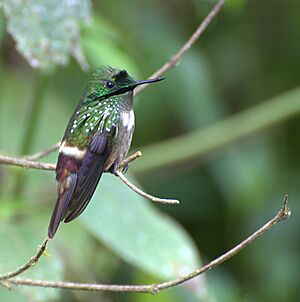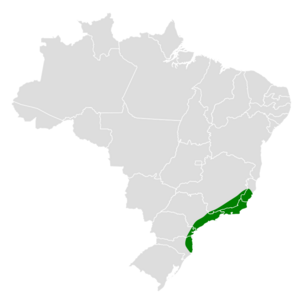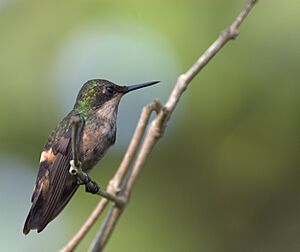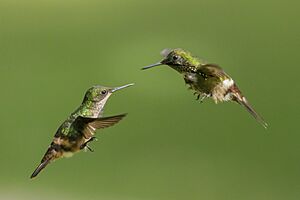Festive coquette facts for kids
Quick facts for kids Festive coquette |
|
|---|---|
 |
|
| Male | |
| Conservation status | |
| Scientific classification | |
| Genus: |
Lophornis
|
| Species: |
chalybeus
|
 |
|
The festive coquette (Lophornis chalybeus) is a tiny, colorful hummingbird. It belongs to a group of hummingbirds called "coquettes." This special bird lives only in Brazil.
Contents
Meet the Festive Coquette
What is a Festive Coquette?
For a while, the festive coquette was grouped with other birds like the butterfly coquette and peacock coquette. Scientists later decided the butterfly coquette was its own species in 2019. The festive coquette is now considered a unique species on its own.
What Does a Festive Coquette Look Like?
This hummingbird is about 7.5 to 9.1 centimeters (3 to 3.6 inches) long. It weighs around 3 grams (0.1 ounces), which is super light! Both male and female birds have a short, straight, black beak.
Their upper body is a shiny bronze-green color. They have a light band across their lower back. Their tail is a pretty purplish copper with light tips on the outer feathers.
Male Festive Coquette's Look
Adult male festive coquettes are very fancy. They have a bright green forehead that shines. Around this green part, they have a band of stiff black feathers. Their cheeks have green tufts with white tips. The feathers around their beak and chin are glittering green with white tips. Their chest is whitish with black stripes. Their belly is grayish-brown with a dark stripe down the middle.
Female Festive Coquette's Look
Adult female festive coquettes look a bit different. They have blackish cheeks but no fancy tufts like the males. They do have a white "moustache" stripe. Their chin is a light buff color with a dark spot. The rest of their underside is brownish with whitish scales. Young festive coquettes look similar to the adult females.
Where Do Festive Coquettes Live?
Finding the Festive Coquette's Home
The festive coquette lives in southeastern Brazil. You can find them from the state of Espírito Santo down to Santa Catarina. There have been a few possible sightings in northeastern Argentina. However, these sightings have not been officially confirmed by bird experts.
Festive Coquette's Favorite Places
These birds like to live in humid forests. They can be found in both old, untouched forests and newer forests that have grown back. They also live in a type of grassland called cerrado. You can spot them from sea level all the way up to 1,000 meters (3,300 feet) high.
How Festive Coquettes Live
How Festive Coquettes Move Around
The festive coquette usually stays in one place. It doesn't travel far. Sometimes, they might move to new areas during different seasons. This could explain why they have been seen in Argentina.
What Do Festive Coquettes Eat?
Festive coquettes love to eat nectar from flowers. They also catch and eat small insects. They get nectar by hovering in front of a flower and sipping from it. Sometimes, they might even poke a hole in the bottom of a flower to "steal" nectar.
They don't protect their feeding spots. However, they will compete with other festive coquettes if they are at the same flowering plant. Besides catching insects in the air, they might also pick them off leaves.
Reproduction and Life Cycle
Male festive coquettes try to attract females by hovering. They will also show off their shiny forehead and cheek feathers. The breeding season for these birds can vary. Some reports say it's from August to November, while others say October to February.
The nest is shaped like a cup. It is made from soft plant material. The female usually hangs the nest from the tip of thin branches. These nests are typically 2 to 5 meters (7 to 16 feet) above the ground. The female sits on two eggs for 13 to 14 days. The young birds leave the nest about 22 days after they hatch.
Sounds of the Festive Coquette
The festive coquette is a quiet bird most of the time. When it is feeding, it might make a short "tsip" or "chip" sound. When it hovers, its wings make a soft, bee-like humming noise.
Protecting the Festive Coquette
Status of the Festive Coquette
The IUCN (International Union for Conservation of Nature) has listed the festive coquette as "Near Threatened." This means that while it's not in immediate danger, its population could become threatened soon. We don't know exactly how many of these birds there are or if their numbers are growing or shrinking.
Why is the Festive Coquette Near Threatened?
The festive coquette lives in a small area. Even though it lives in some protected places, its home is "under threat of deforestation." This means that forests where it lives are being cut down. Protecting these forests is important to help the festive coquette survive.




